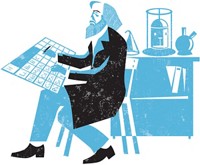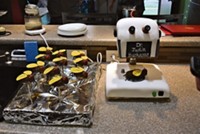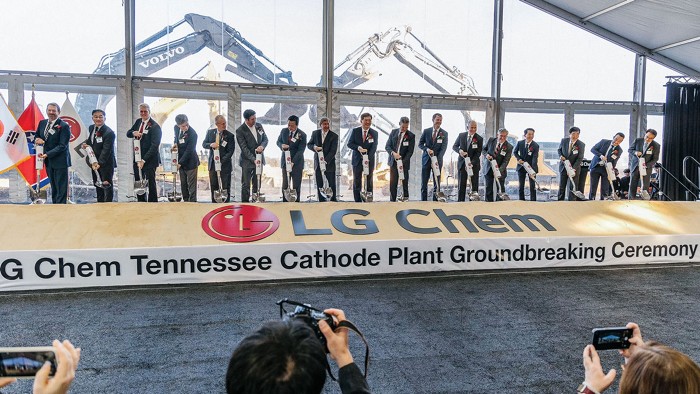Advertisement
Grab your lab coat. Let's get started
Welcome!
Welcome!
Create an account below to get 6 C&EN articles per month, receive newsletters and more - all free.
It seems this is your first time logging in online. Please enter the following information to continue.
As an ACS member you automatically get access to this site. All we need is few more details to create your reading experience.
Not you? Sign in with a different account.
Not you? Sign in with a different account.
ERROR 1
ERROR 1
ERROR 2
ERROR 2
ERROR 2
ERROR 2
ERROR 2
Password and Confirm password must match.
If you have an ACS member number, please enter it here so we can link this account to your membership. (optional)
ERROR 2
ACS values your privacy. By submitting your information, you are gaining access to C&EN and subscribing to our weekly newsletter. We use the information you provide to make your reading experience better, and we will never sell your data to third party members.
Energy Storage
Croissants and Blenders
by Sam Lemonick
November 24, 2019
| A version of this story appeared in
Volume 97, Issue 46
From croissants to capacitors

Inspiration can strike anywhere, anytime. Even, apparently, in the stupor that follows a family Christmas meal.
“We were in the living room, sort of drugged by foods,” recalls Emiliano Bilotti, a polymer scientist at Queen Mary University of London. At the time, Bilotti had been trying to figure out a better way to disperse graphene nanoparticles in polymers, where they tend to warp and clump together. This limits their performance. The answer was in his mother’s rustici, savory vegetable-filled pastries.
Like a croissant, rustico dough is repeatedly flattened and folded to create an airy structure. Bilotti intuited that the same technique could evenly spread graphene nanoparticles between sheets of polymer. His group found the method isolated and protected the nanoparticles even at high weight percentages.
Bilotti’s team is now applying the press-and-fold method to capacitors, which can store and quickly discharge electrical energy. Rather than dispersing nanoparticles, the researchers used the technique to control crystallization in a poly(vinylidene fluoride) polymer. Their croissant-copycat capacitor has the highest reported energy storage value for polymer materials, meaning it could rival the performance of current capacitors while adding the benefits of a polymer’s mechanical properties (Nat. Commun. 2019, DOI: 10.1038/s41467-019-12391-3).
For now, Bilotti and his colleagues are folding their polymers by hand, just like his mother does when she makes her rustici. “It’s quite a time-consuming way,” he tells Newscripts. But commercial croissant-making machines exist, and Bilotti thinks he might be able to adopt their mechanics to produce his capacitors on larger scales.
A cover story
Plenty of teens dream of being on magazine covers. Gabrielle Chiong, a senior at Walnut Hills High School in Cincinnati, already has hers: the Sept. 11, 2019, issue of ACS Applied Materials and Interfaces.

Chiong spent this past summer working as a researcher in Laura B. Sagle’s bionanomaterials lab at the University of Cincinnati. Sagle would normally hire a graphic designer to make art to accompany an article, but knowing that Chiong was interested in illustration, Sagle asked the young woman to make a journal cover and table of contents image for a forthcoming paper (ACS Appl. Mater. Interfaces 2019, DOI:10.1021/acsami.9b09988).
Using the 3-D-modeling software Blender for the first time, Chiong built representations of the silica bead substrate, lipid bilayer, and other elements of the experiment. She continually consulted with Sagle to ensure scientific accuracy. One challenge, she says, was finding the right colors so that each object was visually distinct but the whole palette worked together. She played with a few different angles, too, before settling on one that portrays everything a bit skewed, which she likes.
Sagle says her group was floored when they saw what Chiong had made: “It was amazing.”
Chiong thinks art can help scientists and vice versa. “Since both deal with observing and interpreting,” she says, “being able to appreciate and understand both can allow you to approach problems and solutions with a different mind-set.”
As a senior, Chiong says she’s working on college applications and planning to major in bioengineering. But if she does want to keep making journal art, Sagle thinks she’ll have plenty of work—colleagues have been asking Sagle how to get hold of the artist.
Sam Lemonick wrote this week’s column. Please send comments and suggestions to newscripts@acs.org.





Join the conversation
Contact the reporter
Submit a Letter to the Editor for publication
Engage with us on Twitter